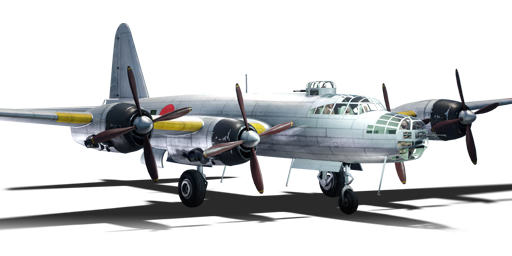



The G8N1, designated as Renzan (連山), was a four-engine heavy bomber designed by Nakajima Aircraft Company for the Imperial Japanese Navy in 1943. It was intended to be a long-range land-based attack plane that could carry a large bomb load and reach speeds of 590 km/h. The first prototype flew in October 1944 and was delivered to the Navy for testing in January 1945. However, the project faced many difficulties due to material shortages, especially aluminium, and Allied air raids. Only four prototypes and three production models were completed before the program was cancelled in June 1945.
It was introduced in Update 1.29. The Renzan is a formidable machine with six powerful 20 mm Type 99 Model 2 Mk 5 cannons to deter enemy planes. It can withstand multiple attacks with its strong defensive armament, high ammo count, and decent armour (for a Japanese aircraft). However, it has a low bomb load of 2,400 kg, making it the least effective heavy bomber in-game for ground attack. The Renzan can still pose a threat in formation or with allies. Unlike other heavy bombers like the Lancaster B Mk I, the Renzan can defend itself without fighter escort, to some extent. Another distinctive feature of the Renzan is its four-engine design. It is one of the few Japanese planes with four engines, along with the G5N1 and the premium B-17E Flying Fortress. This enhances the Renzan's survivability and chances of returning to base.
flaps
flaps
flaps
brake
| Belt | Belt filling | Armor penetration (mm) at a distance: | |||||
|---|---|---|---|---|---|---|---|
| 10 m | 100 m | 500 m | 1000 m | 1500 m | 2000 m | ||
| T/FI/APHE | 26 | 24 | 17 | 10 | 6 | 4 | |
| APHE/APHE/APHE/HEF-T | 26 | 24 | 17 | 10 | 6 | 4 | |
| HEF-T/FI/HEF-T/FI/APHE | 26 | 24 | 17 | 10 | 6 | 4 | |
| Belt | Belt filling | Armor penetration (mm) at a distance: | |||||
|---|---|---|---|---|---|---|---|
| 10 m | 100 m | 500 m | 1000 m | 1500 m | 2000 m | ||
| I/AP-T/HEF-T/T/HEF-I | 18 | 16 | 9 | 5 | 3 | 1 | |
| T/AP-T/AP-T/AP-T/I | 18 | 16 | 9 | 5 | 3 | 1 | |
| AP-T/HEF-T/HEF-I/HEF-T/T | 18 | 16 | 9 | 5 | 3 | 1 | |
| Belt | Belt filling | Armor penetration (mm) at a distance: | |||||
|---|---|---|---|---|---|---|---|
| 10 m | 100 m | 500 m | 1000 m | 1500 m | 2000 m | ||
| I/AP-T/HEF-T/T/HEF-I | 18 | 16 | 9 | 5 | 3 | 1 | |
| T/AP-T/AP-T/AP-T/I | 18 | 16 | 9 | 5 | 3 | 1 | |
| AP-T/HEF-T/HEF-I/HEF-T/T | 18 | 16 | 9 | 5 | 3 | 1 | |












Flight performance | |
|---|---|
Survivability |
|---|
Weaponry | |
|---|---|